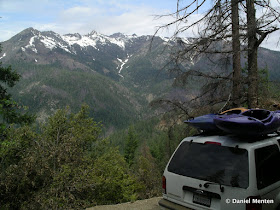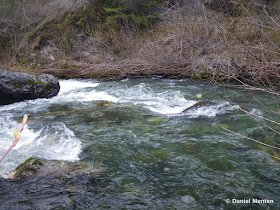The North Trinity is
still one of the steepest and most difficult runs in the Northern California mountains. Reliable spring flows, classic rapids, spectacular wilderness scenery and emerald green water combine to make this one of my favorite runs. Around the corner from put-in, the river starts dropping out in its push towards the Trinity. Much of this section is visible from the shuttle road, high above—it’s much bigger than it looks from the road.
Here is a short video of the North Fork Trinity
Limestone Ridge from Hobo Gulch Rd.
The first two miles pack in the fun drops, with a very continuous and steep nature. The stand-out rapids are the first one (which has a nasty log in it) and the island drop. When the river splits, and the left channel is clogged by a large log, take the smaller right channel. Eddy out, and clamber down the island to scout.

Chris Zawacki styles the First Drop at lower flows (500 cfs).
Paul Fritze boofing the next drop
After the initial 2-mile steep section which contains many ledge drops in steep boulder gardens, the river backs off for a while. One rapid of note is a pinched out flume with a tricky seam. This drop can sneak up on you as there are no large eddies above the tricky horizon line.
Fritze styles the Pinch
After this you reach paradise gorge. Within this beautiful mini-gorge lurks one particularly sticky hole, that would be a rough surf. Be sure and boof hard.
View from inside paradise gorge
Lunch Break below paradise gorge
Purple Lewisia Succulent, Endemic to Trinity Alps
Once through this gorge, you will be at the Cabin of Gaines Horn, who runs a business with his wife Karen making "climbing jewelry", and other fascinating trinkets. The cabins are very beautiful and could be used as an emergency exit point (or put-in), as a trail leads back to the road here. However please respect the private property by not stopping here unless it is necessary. If you happen to see the landowners, they are very nice people, say hi to them for me. Here is a link to their website and Karen's blog
http://www.ruggedcanyonjewelry.com/
Paul Fritze checking out the climbing jewelry
Fascinating Micro-hydro power generator
Many fun rapids are interspersed throughout the middle section. Most are short, steep drops into powerful hydraulics. There are also a couple of fun mini-gorges with sticky holes lurking around to keep you on your toes. One of these we call "party time", though it really should be "scary time", after having three simultaneous swimmers out of one hole. We boat-scouted directly into this drop, and had marginal success, with about 40% of our crew stuck. Orion got the worst treatment, he describes being pinned upside down underwater, his wedged between his boat and an undercut rock with the current holding him in place. Fortunately he was able to muscle his way out of the boat, which remained pinned after he exited. Be careful not to blunder into this rapid on the left, an eddy and easy boof line are on the right side.
Extricating Orion's Boat from "Party Time"
Beautiful wild azalea lines the banks
The river calms down for a while, and another access point exists, where there the Waldorf Crossing trail heads back to the shuttle road on river left. This spot is recognizable where a small creek tumbles down a bedrock shelf into the river on the right. Downstream you reach Mr. Squiggles…a classic drop where the river falls 8 feet into a crack, scout left and boof hard right.
Ben York airing out his boof at Mr. Squiggles
Miguel spawning
The final gorge contains several classic drops as well. Of particular note is Leap of Faith—an 8 foot boof into a very sticky hole. Even at 500 cfs I’ve been violently cartwheeled in this drop. Portaging and scouting this drop can be very difficult due to the vertical canyon walls—be careful to set safety here as Arn’s Falls is just downstream.
Looking back up at the Leap of Faith
The left side of Arn's is a hideous sieved out cataract, the right has a classic line that collected a log several years ago making it unrunnable. The portage on the right can be tricky, and this year we were putting in our boats in a small eddy on the right and paddling the last two drops. The portage route is along the cliff on river right…high water can make this portage much more intimidating. Below here, fun rapids continue all the way to the take-out.
Looking Down Arn's Falls
John Warner running Arn's Falls
Beware of high water on the North Trinity, I wouldn't recommend paddling it with more than 1,200-1,500 cfs unless you are very comfortable in big water. 500 cfs should be considered the minimum. The shuttle is rather simple, to get to take out turn at the sign for Helena, about 5 miles west of Junction City and drive about 1.5 miles to the take-out bridge. To reach put-in continue up this road for about 3 miles to where the marked Hobo Gulch road veers off to the left. Continue for 15 miles to the Hobo Gulch campground. This road can be snowed in during winter, though it usually opens up during march or april.

The boys payin' some dues after a rough day on the North Trin













































